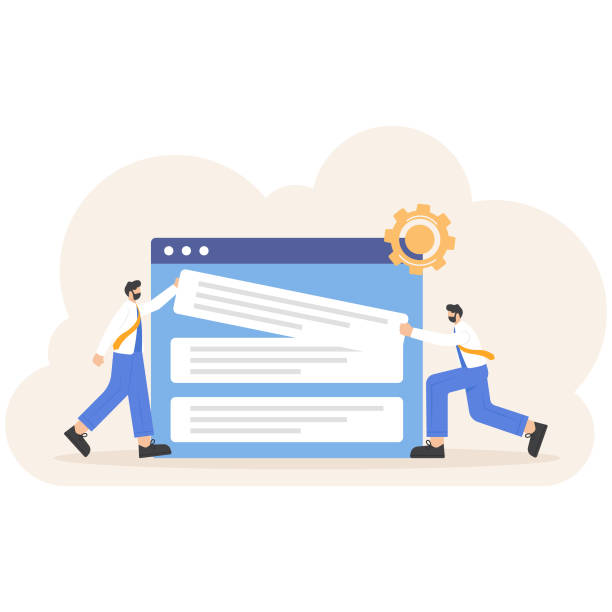اهمیت سئو داخلی و چرا باید به آن توجه کنیم
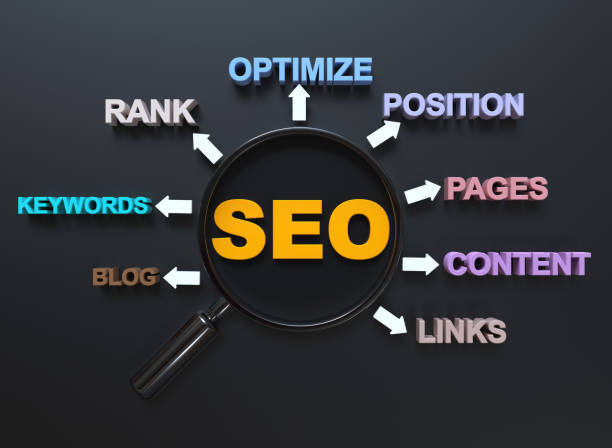
#اموزشی برای همه صاحبان وبسایتها و کسبوکارهای آنلاین، درک و اجرای سئو داخلی (On-Page SEO) از اهمیت بسیار بالایی برخوردار است.
سئو داخلی به مجموعهای از اقدامات گفته میشود که در داخل وبسایت و بر روی صفحات آن انجام میشود تا رتبه بهتری در نتایج موتورهای جستجو کسب کند و ترافیک ارگانیک بیشتری جذب کند.
برخلاف سئو خارجی که به فعالیتهای بیرون از سایت (مانند ساخت بکلینک) میپردازد، سئو داخلی کاملاً تحت کنترل شماست و با بهینهسازی عناصر مختلف صفحه، میتوانید به موتورهای جستجو کمک کنید تا محتوای شما را بهتر درک کرده و آن را به کاربران مرتبط نمایش دهند.
این بهینهسازیها شامل انتخاب کلمات کلیدی مناسب، ساختار URL، بهینهسازی عناوین و توضیحات متا، استفاده از تگهای هدینگ، و بهبود کیفیت محتوا میشود.
در دنیای رقابتی امروز اینترنت، تنها تولید محتوا کافی نیست؛ باید اطمینان حاصل کنید که این محتوا قابل یافتن است.
بدون سئو داخلی قوی، حتی بهترین و کاربردیترین محتوای شما نیز ممکن است هرگز توسط مخاطبان هدف کشف نشود.
در حقیقت، سئو داخلی پایهای است که تمامی استراتژیهای سئوی دیگر بر روی آن بنا میشوند.
درک دقیق الگوریتمهای موتورهای جستجو و اعمال بهترین شیوههای بهینهسازی داخلی به شما کمک میکند تا نه تنها رتبه بهتری کسب کنید، بلکه تجربه کاربری مثبتی نیز برای بازدیدکنندگان خود فراهم آورید که خود عامل مهمی در ماندگاری و بازگشت کاربران به سایت شماست.
این بخش آغازین، یک توضیح کلی از اهمیت و تعریف سئو داخلی ارائه میدهد و به شما کمک میکند تا مسیر یادگیری عمیقتر را آغاز کنید.
از دست دادن مشتریان به دلیل طراحی ضعیف سایت فروشگاهی خسته شدهاید؟ با رساوب، این مشکل را برای همیشه حل کنید!
✅ افزایش فروش و نرخ تبدیل بازدیدکننده به مشتری
✅ تجربه کاربری روان و جذاب برای مشتریان شما⚡ دریافت مشاوره رایگان
تحقیق کلمات کلیدی موثر در سئو داخلی
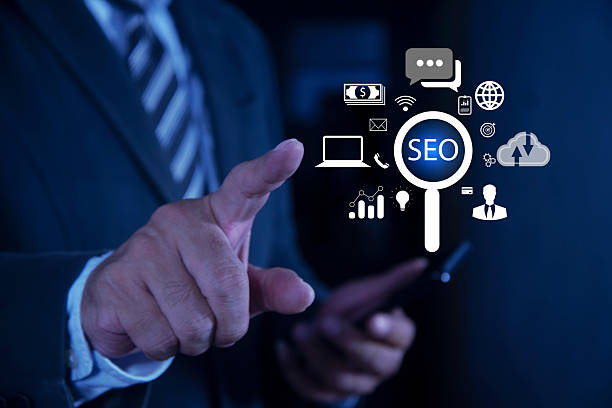
یکی از ارکان اصلی هر استراتژی موفق سئو داخلی، تحقیق جامع و دقیق کلمات کلیدی است.
این فرآیند تخصصی شامل شناسایی عبارات و کلماتی است که کاربران هنگام جستجو در موتورهای جستجو مانند گوگل از آنها استفاده میکنند.
هدف این است که کلماتی را پیدا کنید که نه تنها حجم جستجوی مناسبی دارند، بلکه با محتوای شما و هدف تجاریتان همخوانی کامل داشته باشند.
فراتر از کلمات کلیدی اصلی، باید به کلمات کلیدی طولانی (Long-Tail Keywords) نیز توجه ویژه داشت.
این عبارات طولانیتر و خاصتر، معمولاً حجم جستجوی کمتری دارند، اما نرخ تبدیل بالاتری را به همراه دارند زیرا قصد و نیت کاربر در آنها مشخصتر است.
برای مثال، به جای “سئو”، عبارت “چگونه سئو داخلی وبسایت خود را بهبود دهیم” یک کلمه کلیدی طولانی محسوب میشود.
ابزارهایی مانند Google Keyword Planner، SEMrush، Ahrefs و Ubersuggest میتوانند در این مرحله به شما کمک کنند تا کلمات کلیدی مرتبط، حجم جستجو، و میزان رقابت را تحلیل کنید.
علاوه بر این، درک نیت جستجوی کاربر (User Intent) حیاتی است.
آیا کاربر به دنبال اطلاعات است (informative)، قصد خرید دارد (transactional)، یا به دنبال وبسایت خاصی میگردد (navigational)؟ تطابق محتوای شما با نیت جستجوی کاربر، احتمال دیده شدن و کلیک شدن صفحه شما را به شدت افزایش میدهد و بخش مهمی از بهینهسازی موتورهای جستجو است.
بهینهسازی عناصر داخلی صفحه وب

پس از تحقیق کلمات کلیدی، نوبت به اعمال این کلمات در عناصر مهم داخلی صفحه میرسد.
این مرحله از سئو داخلی کاملاً توضیحی و اجرایی است.
عناوین و توضیحات متا: تگ عنوان (Meta Title) مهمترین عنصر سئو داخلی است که مستقیماً در نتایج جستجو نمایش داده میشود.
باید شامل کلمه کلیدی اصلی و جذاب باشد تا کاربران را به کلیک ترغیب کند.
توضیحات متا (Meta Description) نیز اگرچه مستقیماً در رتبهبندی تأثیری ندارد، اما به افزایش نرخ کلیک (CTR) کمک میکند.
تگهای هدینگ (Heading Tags): استفاده صحیح از H1 تا H6 ساختار محتوای شما را برای موتورهای جستجو و کاربران مشخص میکند.
H1 برای عنوان اصلی صفحه و شامل کلمه کلیدی اصلی است، در حالی که H2 تا H6 برای زیرعنوانها و سازماندهی متن به کار میروند.
ساختار URL: URLها باید کوتاه، خوانا و شامل کلمات کلیدی مرتبط باشند.
URLهای ساده و منطقی هم برای کاربران و هم برای موتورهای جستجو قابل فهمتر هستند.
چگالی کلمات کلیدی: استفاده از کلمات کلیدی در متن باید طبیعی باشد.
از پر کردن بیش از حد کلمات کلیدی (Keyword Stuffing) پرهیز کنید، زیرا این کار میتواند منجر به جریمه از سوی موتورهای جستجو شود.
در عوض، از مترادفها و کلمات کلیدی مرتبط (LSI Keywords) برای غنیسازی محتوا استفاده کنید.
سرعت بارگذاری صفحه: سرعت بالا برای تجربه کاربری و رتبهبندی مهم است.
استفاده از تصاویر بهینهسازی شده، کشینگ و فشردهسازی کدها میتواند به افزایش سرعت کمک کند.
در اینجا یک جدول از عناصر کلیدی سئو داخلی و توصیههای مربوط به آنها آورده شده است:
| عنصر سئو داخلی | توضیح | توصیه کلیدی |
|---|---|---|
| تگ عنوان (Meta Title) | عنوان صفحه که در نتایج جستجو نمایش داده میشود. | کوتاه، جذاب، شامل کلمه کلیدی اصلی، حداکثر 60-70 کاراکتر. |
| توضیحات متا (Meta Description) | خلاصهای از محتوا که زیر عنوان در نتایج جستجو نمایش داده میشود. | ترغیبکننده، شامل کلمات کلیدی مرتبط، حداکثر 150-160 کاراکتر. |
| تگهای هدینگ (H1-H6) | ساختاردهی محتوا و مشخص کردن اهمیت بخشها. | H1 فقط یک بار در هر صفحه، H2-H6 برای زیرعنوانها، شامل کلمات کلیدی فرعی. |
| URL | آدرس اینترنتی صفحه. | کوتاه، خوانا، شامل کلمه کلیدی اصلی، استفاده از خط تیره (-) به جای فاصله. |
| محتوای اصلی | متن، تصاویر، ویدئوها و سایر عناصر محتوایی صفحه. | منحصر به فرد، جامع، پاسخگوی نیاز کاربر، با کیفیت و مرتبط. |
تولید محتوای باکیفیت و جذاب برای سئو داخلی
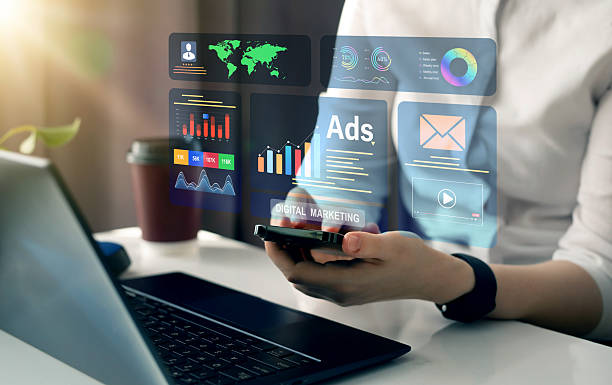
قلب تپنده هر استراتژی موفق سئو داخلی، تولید محتوای باکیفیت و ارزشمند است.
محتوای شما باید نه تنها برای موتورهای جستجو بهینه باشد، بلکه از همه مهمتر، نیازها و سوالات کاربران را به طور کامل پاسخ دهد.
محتوای باکیفیت به معنای محتوایی است که محتوای سوالبرانگیز نیست، بلکه جامع، دقیق، عمیق و بهروز باشد.
اصالت و منحصر به فرد بودن: از کپی کردن محتوا از سایر وبسایتها جداً خودداری کنید.
موتورهای جستجو به محتوای اصیل و منحصر به فرد ارزش بیشتری میدهند.
عمق و جامعیت: محتوای شما باید موضوع را به طور کامل پوشش دهد.
اگر مقالهای در مورد “سئو داخلی” مینویسید، باید تمامی جنبههای آن را، از اصول اولیه تا نکات پیشرفته، در بر گیرد.
محتوای کوتاه و سطحی معمولاً رتبه خوبی کسب نمیکند.
خوانایی: استفاده از پاراگرافهای کوتاه، جملات ساده، لیستها (بولد و شمارهگذاری شده)، و فضای خالی (whitespace) میتواند خوانایی متن را به شدت افزایش دهد.
خوانایی نه تنها برای کاربران مهم است، بلکه به موتورهای جستجو نیز در درک ساختار محتوا کمک میکند.
تازگی محتوا: به طور منظم محتوای قدیمی خود را بهروزرسانی کنید و محتوای جدید اضافه نمایید.
موتورهای جستجو به محتوای تازه و بهروز اهمیت میدهند.
این کار نشان میدهد که وبسایت شما فعال و پویا است.
مدیریت تجربه کاربر: محتوای شما باید کاربر را درگیر کند.
استفاده از عناصر بصری جذاب مانند تصاویر، ویدئوها، اینفوگرافیکها و نمودارها میتواند تجربه کاربری را بهبود بخشد و زمان ماندگاری کاربر در صفحه را افزایش دهد که یک سیگنال مثبت برای موتورهای جستجو محسوب میشود.
در نهایت، محتوایی که کاربران دوست دارند و با آن تعامل میکنند، همیشه در سئو موفق خواهد بود.
آیا بازدیدکنندگان سایت فروشگاهیتان قبل از خرید، آنجا را ترک میکنند؟ دیگر نگران نباشید! با خدمات طراحی سایت فروشگاهی حرفهای رساوب، مشکل عدم تبدیل بازدیدکننده به مشتری را برای همیشه حل کنید!
✅ افزایش قابل توجه نرخ تبدیل و فروش
✅ تجربه کاربری بینظیر و جذاب
⚡ همین حالا برای دریافت مشاوره رایگان با ما تماس بگیرید!
نقش لینکسازی داخلی در بهبود رتبه

لینکسازی داخلی (Internal Linking) یکی از جنبههای کلیدی و اغلب نادیده گرفته شده در استراتژی سئو داخلی است که به عنوان یک راهنمایی بسیار مؤثر عمل میکند.
لینکهای داخلی، پیوندهایی هستند که صفحات مختلف وبسایت شما را به یکدیگر متصل میکنند.
این لینکها نقش حیاتی در سه جنبه اصلی سئو دارند:
ناوبری وبسایت: لینکهای داخلی به کاربران کمک میکنند تا به راحتی در وبسایت شما حرکت کنند و به محتوای مورد نظرشان دسترسی پیدا کنند.
این بهبود تجربه کاربری منجر به کاهش نرخ پرش (Bounce Rate) و افزایش زمان ماندگاری در سایت میشود.
گذردهی اعتبار لینک: موتورهای جستجو از لینکهای داخلی برای کشف صفحات جدید و درک ساختار وبسایت شما استفاده میکنند.
زمانی که یک صفحه دارای اعتبار لینک (Link Equity یا PageRank) بالایی است، لینکهای داخلی آن اعتبار را به صفحات دیگر منتقل میکنند و به آنها کمک میکنند تا در رتبهبندی بهبود یابند.
این به معنای آن است که میتوانید با لینک دادن از صفحات قویتر خود به صفحات هدف، آنها را تقویت کنید.
درک محتوا: متن لینک (Anchor Text) که برای لینکهای داخلی استفاده میکنید، به موتورهای جستجو کمک میکند تا موضوع صفحه لینک شده را درک کنند.
استفاده از کلمات کلیدی مرتبط در انکر تکست، سیگنال قویتری به موتورهای جستجو میفرستد.
برای مثال، اگر در مورد “بهینهسازی تصاویر” مقالهای دارید، میتوانید از عبارت “نکات بهینهسازی تصاویر” به عنوان انکر تکست برای لینک دادن به آن صفحه استفاده کنید.
ایجاد یک ساختار لینکسازی داخلی منطقی و سلسله مراتبی، مانند یک هرم، که در آن صفحات اصلی به صفحات فرعی و عمیقتر لینک میدهند، میتواند قدرت سئویی شما را به شدت افزایش دهد.
همیشه مطمئن شوید که لینکهای داخلی شما طبیعی به نظر برسند و به ارزش کاربر اضافه کنند.
بهینهسازی تصاویر برای سرعت و دیده شدن

تصاویر نقش مهمی در جذابیت بصری و تجربه کاربری یک وبسایت ایفا میکنند، اما اگر به درستی بهینه نشوند، میتوانند سرعت بارگذاری صفحه را به شدت کاهش دهند و به سئو داخلی آسیب بزنند.
بهینهسازی تصاویر یکی از جنبههای سرگرمکننده و در عین حال حیاتی سئو است که اغلب نادیده گرفته میشود.
فشردهسازی و تغییر اندازه: اولین قدم در بهینهسازی تصاویر، فشردهسازی آنها بدون افت کیفیت قابل توجه و تغییر اندازه آنها به ابعاد مناسب است.
تصاویر بزرگ و با کیفیت بالا، اگرچه زیبا به نظر میرسند، اما به شدت به سرعت سایت لطمه میزنند.
از ابزارهای آنلاین یا افزونههای CMS برای فشردهسازی استفاده کنید و اطمینان حاصل کنید که ابعاد تصویر با فضایی که قرار است اشغال کند، متناسب است.
فرمت مناسب تصویر: انتخاب فرمت مناسب نیز بسیار مهم است.
فرمتهایی مانند JPEG برای عکسها با جزئیات زیاد، PNG برای تصاویر با شفافیت یا لوگوها، و WebP (که فرمتی جدیدتر و کارآمدتر است) برای هر دو نوع تصویر بسیار مناسب هستند.
WebP معمولاً حجم کمتری نسبت به JPEG و PNG دارد و توسط اکثر مرورگرهای مدرن پشتیبانی میشود.
متن جایگزین (Alt Text): متن جایگزین یا Alt Text یک توضیح متنی از تصویر است که در صورتی که تصویر بارگذاری نشود، نمایش داده میشود.
این متن برای موتورهای جستجو نیز بسیار مهم است زیرا به آنها کمک میکند تا محتوای تصویر را درک کنند.
Alt Text باید توصیفی و شامل کلمات کلیدی مرتبط باشد، اما از پر کردن بیرویه کلمات کلیدی خودداری کنید.
نام فایل تصویر: نام فایل تصویر نیز باید توصیفی و شامل کلمات کلیدی باشد.
به جای “IMG_1234.jpg”، از “سئو-داخلی-تصویر-بهینه.jpg” استفاده کنید.
این کار به موتورهای جستجو کمک میکند تا ارتباط تصویر با محتوای صفحه را بهتر درک کنند و در نتایج جستجوی تصاویر نیز دیده شوید.
جنبههای فنی سئو داخلی برای عملکرد بهتر

علاوه بر محتوا و ساختار بصری، جنبههای فنی نیز نقش محوری در سئو داخلی ایفا میکنند.
این بخش تحلیلی و فنی، به شما کمک میکند تا مطمئن شوید زیرساخت سایت شما برای موتورهای جستجو بهینه است.
سرعت بارگذاری سایت (Page Speed): سرعت سایت یک عامل رتبهبندی مهم است.
کاربران و موتورهای جستجو، هر دو، صفحات سریع را ترجیح میدهند.
میتوانید سرعت سایت خود را با ابزارهایی مانند Google PageSpeed Insights و GTmetrix بررسی کنید و توصیههای آنها را برای بهبود سرعت اعمال نمایید.
بهینهسازی تصاویر، فشردهسازی فایلهای CSS و JavaScript، و استفاده از CDN (شبکه توزیع محتوا) از جمله راههای افزایش سرعت هستند.
سازگاری با موبایل (Mobile-Friendliness): با توجه به افزایش چشمگیر کاربران موبایل، داشتن یک وبسایت واکنشگرا (Responsive) که در دستگاههای مختلف به خوبی نمایش داده میشود، حیاتی است.
گوگل از رویکرد Mobile-First Indexing استفاده میکند، به این معنی که نسخه موبایل سایت شما را برای ایندکس و رتبهبندی در نظر میگیرد.
نشانه گذاری اسکیما (Schema Markup): اسکیما مارکاپ کدی است که به وبسایت شما اضافه میشود و به موتورهای جستجو کمک میکند تا محتوای شما را بهتر درک کنند.
این کد به موتورها اجازه میدهد تا اطلاعات خاصی مانند نظرات کاربران، قیمت محصولات، اطلاعات تماس، دستور پخت، و رویدادها را مستقیماً در نتایج جستجو (Rich Snippets) نمایش دهند که میتواند نرخ کلیک را به شدت افزایش دهد.
فایل robots.txt و نقشه سایت (Sitemap.xml): فایل robots.txt به موتورهای جستجو میگوید که کدام بخشهای سایت شما را میتوانند بخزند و کدام بخشها را نباید بخزند.
نقشه سایت (Sitemap.xml) نیز لیستی از تمام صفحات مهم سایت شما را به موتورهای جستجو ارائه میدهد تا خزش آنها راحتتر باشد.
اطمینان از صحت این فایلها برای سئوی فنی ضروری است.
در اینجا یک جدول دیگر برای نمایش جنبههای فنی مهم آورده شده است:
| جنبه فنی | اهمیت | ابزارهای بررسی / راهکارها |
|---|---|---|
| سرعت بارگذاری سایت | مهم برای تجربه کاربری و رتبهبندی گوگل. | Google PageSpeed Insights, GTmetrix، فشردهسازی تصاویر، CDN. |
| سازگاری با موبایل | ضروری برای ایندکس موبایل-اول و رضایت کاربران موبایل. | Google Mobile-Friendly Test، طراحی واکنشگرا (Responsive Design). |
| اسکیما مارکاپ | کمک به موتورهای جستجو در درک بهتر محتوا و نمایش ریچ اسنیپتها. | Schema.org، Google Structured Data Testing Tool. |
| فایل robots.txt | کنترل خزش رباتهای موتور جستجو. | Google Search Console (Robots.txt Tester). |
| نقشه سایت (Sitemap.xml) | ارائه لیستی از صفحات مهم به موتورهای جستجو. | Google Search Console (Sitemaps). |
| گواهی SSL (HTTPS) | امنیت و اعتماد کاربران، عامل رتبهبندی کوچک. | نصب گواهی SSL از طریق هاستینگ. |
تجربه کاربری و تاثیر آن بر سئو داخلی

در سالهای اخیر، موتورهای جستجو به طور فزایندهای بر تجربه کاربری (User Experience یا UX) به عنوان یک عامل رتبهبندی توجه کردهاند.
یک تجربه کاربری عالی نه تنها کاربران را راضی نگه میدارد، بلکه سیگنالهای مثبتی به موتورهای جستجو میفرستد که مستقیماً بر سئو داخلی شما تأثیر میگذارد.
نرخ پرش (Bounce Rate): اگر کاربران به سرعت از سایت شما خارج شوند (نرخ پرش بالا)، این نشان میدهد که محتوای شما مرتبط یا جذاب نبوده است.
موتورهای جستجو این را به عنوان یک سیگنال منفی در نظر میگیرند و میتواند به رتبه شما آسیب بزند.
زمان ماندگاری در صفحه (Dwell Time): مدت زمانی که کاربر در صفحه شما میماند، نشاندهنده میزان درگیری او با محتوا است.
هرچه زمان ماندگاری بیشتر باشد، نشان میدهد که کاربر محتوای شما را مفید و مرتبط یافته است، که یک سیگنال مثبت برای موتورهای جستجو است.
سهولت ناوبری: یک وبسایت که ناوبری آسان و شهودی دارد، کاربران را تشویق میکند تا صفحات بیشتری را مشاهده کنند و زمان بیشتری را در سایت بگذرانند.
منوهای واضح، ساختار سلسله مراتبی منطقی و لینکهای داخلی مناسب به این امر کمک میکنند.
قابلیت خواندن: همانطور که پیشتر اشاره شد، محتوای خوانا و سازمانیافته، تجربه کاربر را بهبود میبخشد.
استفاده از فونتهای مناسب، اندازه متن کافی، کنتراست رنگی خوب و پاراگرافهای کوتاه، به خوانایی کمک میکند.
طراحی واکنشگرا و سرعت: این دو عامل فنی که در بخش قبل توضیح داده شد، ارتباط مستقیمی با تجربه کاربری دارند.
یک سایت کند یا سایتی که در موبایل خوب نمایش داده نمیشود، تجربه کاربری بدی را ایجاد میکند.
در مجموع، تمرکز بر UX به معنای تمرکز بر کاربر است و هرچه کاربران از سایت شما راضیتر باشند، شانس شما برای رتبهبندی بهتر در نتایج جستجو بیشتر خواهد بود.
آیا نگرانید سایت قدیمی شرکتتان مشتریان جدید را فراری دهد؟ رساوب با طراحی سایت شرکتی مدرن و کارآمد، این مشکل را حل میکند.
✅ اعتبار برند شما را افزایش میدهد.
✅ به جذب هدفمند مشتریان کمک میکند.
⚡ برای مشاوره رایگان با رساوب تماس بگیرید!
نظارت و تحلیل عملکرد سئو داخلی
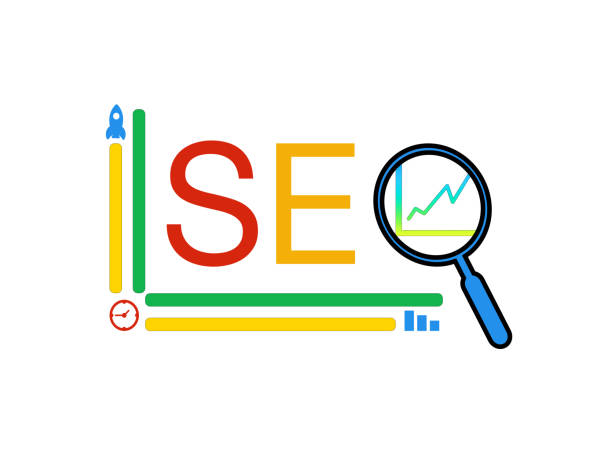
پس از اعمال استراتژیهای سئو داخلی، نظارت و تحلیل مداوم عملکرد برای اطمینان از اثربخشی آنها و شناسایی فرصتهای بهبود بسیار حیاتی است.
این بخش به شما ابزارهای خبری و تحلیلی مورد نیاز را معرفی میکند.
Google Analytics: این ابزار رایگان اطلاعات جامعی در مورد بازدیدکنندگان وبسایت شما ارائه میدهد.
میتوانید ببینید کاربران از کجا آمدهاند، چه مدت در سایت شما ماندهاند، کدام صفحات را بازدید کردهاند، نرخ پرش شما چقدر است و اطلاعات جمعیتشناختی کاربران را بررسی کنید.
تحلیل این دادهها به شما کمک میکند تا رفتار کاربران را درک کرده و صفحات ضعیف را شناسایی کنید.
Google Search Console: این ابزار نیز رایگان است و اطلاعات مستقیمی از گوگل در مورد عملکرد سایت شما در نتایج جستجو ارائه میدهد.
میتوانید ببینید کدام کلمات کلیدی باعث شدهاند سایت شما در نتایج ظاهر شود، چند بار کلیک شدهاید (CTR)، کدام صفحات ایندکس شدهاند یا مشکل خزش دارند، و آیا سایت شما مشکلات امنیتی یا موبایلی دارد.
این ابزار برای رفع خطاهای فنی و پایش رتبهبندی کلمات کلیدی بسیار ارزشمند است.
ابزارهای پولی سئو: ابزارهایی مانند SEMrush، Ahrefs و Moz Pro اطلاعات عمیقتری در مورد سئو ارائه میدهند، از جمله تحلیل رقبا، فرصتهای کلمات کلیدی، بررسی بکلینکها، و حسابرسی سایت (Site Audit).
این ابزارها برای متخصصان سئو و کسبوکارهای بزرگتر که نیاز به تحلیلهای پیشرفتهتر دارند، بسیار مفید هستند.
پایش رتبهبندی کلمات کلیدی: به طور منظم رتبهبندی صفحات خود را برای کلمات کلیدی هدف پایش کنید.
این کار به شما نشان میدهد که آیا استراتژیهای سئوی شما در حال نتیجه دادن هستند یا نیاز به تغییر دارند.
تحلیل دادهها به شما امکان میدهد تا تصمیمات مبتنی بر داده بگیرید و استراتژی سئوی داخلی خود را به طور مداوم بهینه کنید تا بهترین نتایج را کسب کنید.
استراتژیهای پیشرفته و روندهای آتی سئو داخلی
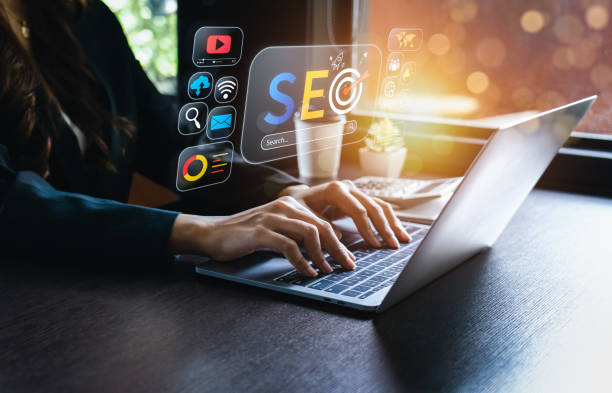
دنیای سئو همواره در حال تغییر و تکامل است و سئو داخلی نیز از این قاعده مستثنی نیست.
برای پیشرو ماندن، باید از استراتژیهای پیشرفته و روندهای آتی آگاه باشید.
این بخش یک راهنمایی جامع برای آینده سئو است.
تمرکز بر نیت جستجو (Search Intent): موتورهای جستجو به طور فزایندهای بر درک نیت واقعی کاربر در پشت هر جستجو تمرکز میکنند.
محتوای شما باید نه تنها کلمات کلیدی را شامل شود، بلکه به طور کامل به نیت کاربر پاسخ دهد.
این به معنای تولید محتوایی است که نه تنها اطلاعاتی باشد، بلکه مشکلات کاربران را حل کند و به سوالات آنها پاسخ دهد.
محتوای جامع و عمیق (Topic Clusters & Pillar Pages): به جای تولید مقالات مجزا و کمعمق برای هر کلمه کلیدی، استراتژی محتوای خود را بر اساس خوشههای موضوعی (Topic Clusters) و صفحات ستون (Pillar Pages) بنا کنید.
یک صفحه ستون، محتوای جامعی در مورد یک موضوع کلی است و به مقالات فرعی متعددی لینک میدهد که جزئیات بیشتری در مورد زیرموضوعات ارائه میدهند.
این ساختار نه تنها به سئو داخلی کمک میکند، بلکه ناوبری سایت را نیز بهبود میبخشد.
سئوی صوتی (Voice Search SEO): با افزایش استفاده از دستیارهای صوتی مانند گوگل اسیستنت و سیری، بهینهسازی برای جستجوی صوتی اهمیت فزایندهای پیدا کرده است.
جستجوهای صوتی معمولاً طولانیتر، محاورهایتر و شبیه به سوالات هستند.
بنابراین، استفاده از سوالات و پاسخهای طبیعی در محتوای خود و تمرکز بر کلمات کلیدی طولانی، در این زمینه مؤثر است.
هوش مصنوعی در سئو: الگوریتمهای گوگل مانند RankBrain، BERT و MUM از هوش مصنوعی برای درک بهتر زبان طبیعی و نیت جستجو استفاده میکنند.
این بدان معناست که محتوای شما باید به گونهای نوشته شود که هم برای انسان و هم برای هوش مصنوعی قابل درک باشد.
تمرکز بر کیفیت، ارتباط، و جامعیت محتوا از اهمیت بالایی برخوردار است.
تجربه هسته وب (Core Web Vitals): این معیارها که توسط گوگل معرفی شدهاند، بر جنبههای واقعی تجربه کاربری مانند سرعت بارگذاری، تعامل و ثبات بصری تمرکز دارند.
بهینهسازی این معیارها برای بهبود رتبهبندی در سالهای آینده ضروری است.
با پیروی از این روندها و بهروزرسانی مداوم استراتژی سئو داخلی خود، میتوانید وبسایت خود را برای موفقیت در آینده آماده کنید.
سوالات متداول
| سوال (Question) | پاسخ (Answer) |
|---|---|
| سئو داخلی (On-page SEO) چیست؟ | سئو داخلی به مجموعه اقداماتی گفته میشود که در داخل وبسایت شما انجام میشود تا رتبه آن در نتایج موتورهای جستجو بهبود یابد. این شامل بهینهسازی محتوا، ساختار سایت و کد HTML است. |
| چرا سئو داخلی مهم است؟ | سئو داخلی به موتورهای جستجو کمک میکند تا محتوای صفحه شما را درک کنند و تشخیص دهند که آیا محتوای شما برای جستجوگران مرتبط است یا خیر. این پایه و اساس هر استراتژی سئویی موفق است. |
| عناصر کلیدی سئو داخلی کدامند؟ | عنوان صفحه (Title Tag)، توضیحات متا (Meta Description)، استفاده از کلمات کلیدی، بهینهسازی تصاویر، ساختار هدینگ (H1, H2, …)، لینکسازی داخلی و کیفیت محتوا از عناصر کلیدی هستند. |
| چگونه عنوان صفحه (Title Tag) را بهینه کنیم؟ | عنوان صفحه باید شامل کلمه کلیدی اصلی باشد، جذاب و ترغیبکننده برای کلیک باشد و طول آن بین ۵۰ تا ۶۰ کاراکتر (یا پیکسل مناسب) باشد تا به طور کامل در نتایج جستجو نمایش داده شود. |
| توضیحات متا (Meta Description) چه نقشی در سئو داخلی دارد؟ | توضیحات متا خلاصهای از محتوای صفحه است که در زیر عنوان در نتایج جستجو نمایش داده میشود. اگرچه مستقیماً بر رتبهبندی تأثیر ندارد، اما با افزایش نرخ کلیک (CTR) به سئو کمک میکند. |
| اهمیت استفاده از ساختار هدینگ (H1, H2, H3) در سئو داخلی چیست؟ | هدینگها محتوای صفحه را ساختارمند و خواندن آن را آسانتر میکنند. H1 معمولاً عنوان اصلی صفحه است و باید شامل کلمه کلیدی باشد. H2 و H3 برای سازماندهی زیربخشها استفاده میشوند و به موتورهای جستجو در درک سلسله مراتب محتوا کمک میکنند. |
| چگونه کلمات کلیدی را به طور موثر در محتوا استفاده کنیم؟ | کلمات کلیدی باید به طور طبیعی و منطقی در سراسر محتوا، از جمله مقدمه، بدنه و نتیجهگیری استفاده شوند. از پر کردن بیش از حد کلمات کلیدی (Keyword Stuffing) پرهیز کنید. |
| بهینهسازی تصاویر برای سئو داخلی شامل چه مراحلی است؟ | شامل فشردهسازی تصاویر برای کاهش حجم، استفاده از نام فایلهای توصیفی، اضافه کردن متن جایگزین (Alt Text) مناسب و بهینهسازی عنوان و توضیحات تصویر است. Alt Text برای دسترسپذیری و کمک به موتورهای جستجو برای درک محتوای تصویر حیاتی است. |
| لینکسازی داخلی (Internal Linking) چیست و چه مزایایی دارد؟ | لینکسازی داخلی به معنای ایجاد لینک از یک صفحه در وبسایت شما به صفحه دیگری در همان وبسایت است. این کار به کاربران کمک میکند تا به راحتی در سایت شما حرکت کنند، اعتبار صفحه را در سراسر سایت توزیع میکند و به موتورهای جستجو کمک میکند تا ساختار سایت شما را بهتر درک کنند. |
| اهمیت کیفیت محتوا در سئو داخلی چیست؟ | محتوای با کیفیت، دقیق، جامع و ارزشمند برای کاربران، سنگ بنای سئو داخلی است. موتورهای جستجو محتوایی را که نیازهای کاربران را برآورده میکند، ترجیح میدهند. محتوای با کیفیت منجر به زمان بیشتر حضور کاربر در سایت (Dwell Time) و کاهش نرخ پرش (Bounce Rate) میشود که سیگنالهای مثبت سئو هستند. |
و دیگر خدمات آژانس تبلیغاتی رسا وب در زمینه تبلیغات
گوگل ادز هوشمند: پلتفرمی خلاقانه برای بهبود افزایش فروش با طراحی رابط کاربری جذاب.
اتوماسیون فروش هوشمند: راهحلی سریع و کارآمد برای مدیریت کمپینها با تمرکز بر اتوماسیون بازاریابی.
بهینهسازی نرخ تبدیل هوشمند: طراحی شده برای کسبوکارهایی که به دنبال رشد آنلاین از طریق استفاده از دادههای واقعی هستند.
تحلیل داده هوشمند: بهینهسازی حرفهای برای تعامل کاربران با استفاده از طراحی رابط کاربری جذاب.
بازاریابی مستقیم هوشمند: خدمتی اختصاصی برای رشد تعامل کاربران بر پایه تحلیل هوشمند دادهها.
و بیش از صد ها خدمات دیگر در حوزه تبلیغات اینترنتی ،مشاوره تبلیغاتی و راهکارهای سازمانی
تبلیغات اینترنتی | استراتژی تبلیعاتی | ریپورتاژ آگهی
منابع
? آیا آمادهاید تا کسبوکار خود را در دنیای دیجیتال متحول کنید؟ آژانس دیجیتال مارکتینگ رساوب آفرین، با ارائه خدمات حرفهای از جمله طراحی سایت وردپرس و بهینهسازی سئو، مسیر موفقیت آنلاین شما را هموار میکند. با ما آیندهای درخشان برای برند خود بسازید.
📍 تهران ، خیابان میرداماد ،جنب بانک مرکزی ، کوچه کازرون جنوبی ، کوچه رامین پلاک 6

